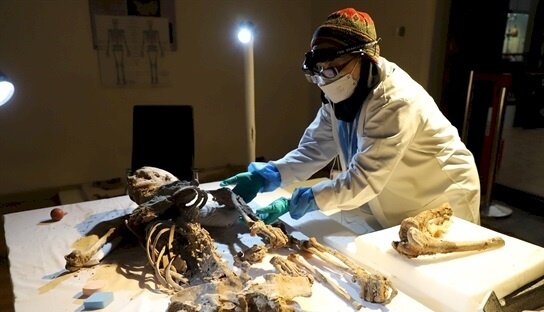

TEHRAN –A documenting and cleansing project has come to an end on an ancient salt man and his belongings being kept at an archaeology museum in Iran’s Zanjan province, the head of the project has said.
“The salt man No. 5, which was discovered in Iran’s Chehrabad Salt Mine decades ago, has been cleaned, documented, and photographed and now it is the subject of further studies by a team of archeologists and other experts, ILNA quoted Abolfazl Aali as saying on Thursday.
Showcased at Zolfaghari Museum, the temperature and humidity of the salt man are carefully monitored every day to make sure it enjoys standard and optimal conditions, he explained.
Earlier this month, Zanjan’s provincial tourism chief Amir Arjmand announced that a project for documenting and reorganizing [all] ancient salt men and their belongings was commenced in Zolfaghari Museum.
In 1993, miners in the Douzlakh Salt Mine, near Hamzehli and Chehrabad villages, accidentally came across a mummified head, dated to 300 CE. The head was very well preserved, to the extent that his pierced ear was still holding the gold earring. The hair, beard, and mustaches were reddish, and his impressive leather boot still contained parts of his leg and foot, according to the Ancient History Encyclopedia.
However, in 2004, the miners discovered yet another “saltman,” which was followed by further excavation unearthing remains of a human body along with a large number of artifacts made of wood, metal tools, clothing, and pottery.
In 2005, a systematic excavation began, three more mummies were excavated, and a sixth remained in situ due to lack of funds for its storage. The context of the remains suggested that a collapse in the mine had caused the death of the miners in question.
The first mummy dubbed the “saltman,” is on display in the National Museum of Iran in Tehran. He still looks very impressive.
This particular “saltman” was originally dated based on the archaeological material found with him. Later, the mummy was carbon dated, which placed him in 500 CE (1750 BP, that is, “before present” or 1750 years ago), the Sasanian Empire’s height. The second “Saltman” was carbon-dated to 1554 BP, which placed him in the same era as the first “saltman,” the Sasanian era.
The third, fourth, and fifth “saltmen” were also carbon dated. The third body was dated and placed in 2337 BP, the fourth body in 2301 BP, and the fifth mummy was dated to 2286 BP, placing them all in the Achaemenid period.
Saltman No. 5 had tapeworm eggs from the Taenia sp. genus in his system. These were identified during the study of his remains. The find indicates the consumption of raw or undercooked meat, and this is the first case of this parasite in ancient Iran and the earliest evidence of ancient intestinal parasites in the area. The best preserved and probably the most harrowing of the bodies is “saltman” No. 4. A sixteen-year-old miner, caught in the moment of death, crushed by a cave-in.
ABU/AFM
 RSS Feed
RSS Feed















 January 29th, 2021
January 29th, 2021  Awake Goy
Awake Goy  Posted in
Posted in  Tags:
Tags: 













